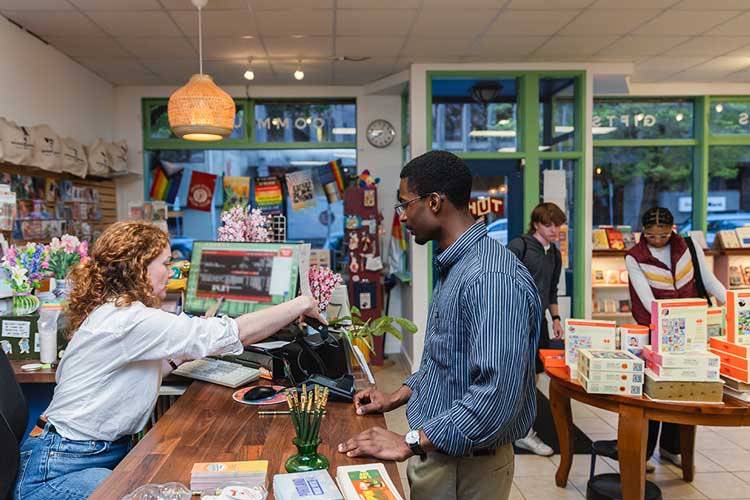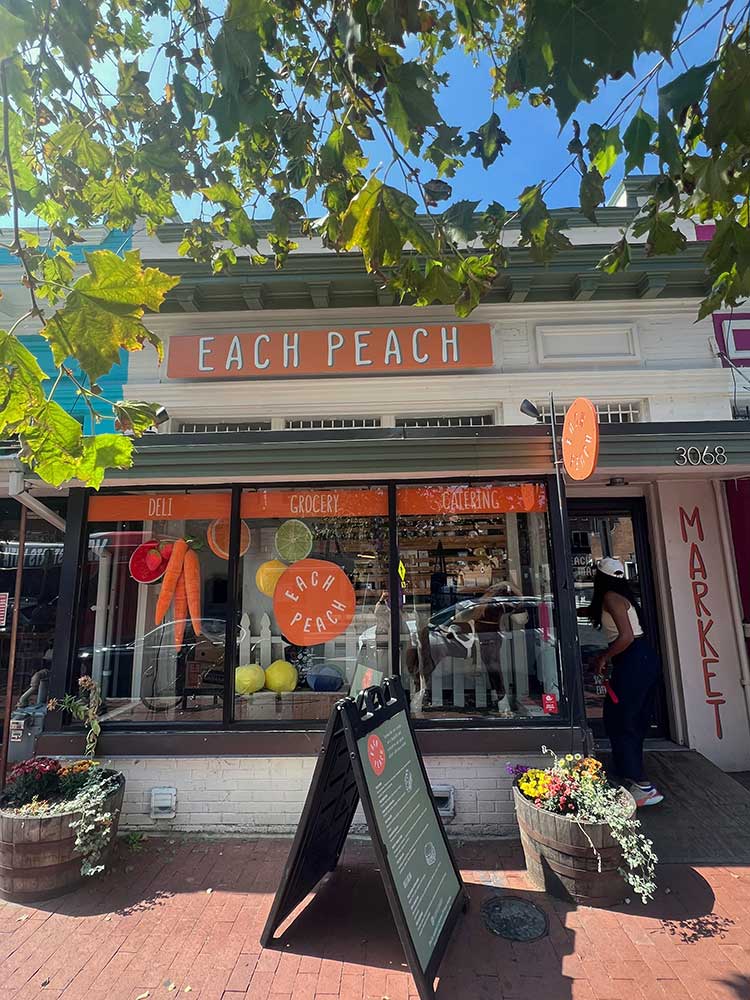Last updated November 3, 2025

“Think globally, shop locally.”
T-shirts, bumper stickers, and well-meaning consumers toss this phrase around all the time. Many people claim they’d prefer to buy everything from books to Barbie dolls at local retailers rather than Amazon or big chains. One recent survey found that up to 90 percent of Americans would like to shop local more often.
There are good reasons for doing this. “A dollar spent in your own community recirculates and goes back to local residents through businesses paying employees and ultimately supports the economic health of the place you live,” said Monica Haynes, director of the Bureau of Business and Economic Research at the University of Minnesota Duluth.
But price, convenience, and selection often deter people from shopping at nearby businesses. That includes me. Even though I’ve written about—and preached the gospel of—buying local for decades, I still hear the siren call of Amazon’s quick shipping on beauty products and Target’s low prices for workout clothes and toilet paper.
To find out whether shopping locally is truly doable—and affordable—I spent 30 days attempting to buy only from local businesses. Along the way, I tracked my prices and experience. Here’s what I learned.
The Rules
I began my experiment on July 7, 2025, and recorded what, where, and how much my husband and I bought until August 7. The rules were simple: For one month, we’d make no purchases at chain stores or non-local websites of any kind, including pharmacies and grocery stores. The whole time, we’d track what we spent. And any slip-ups—and yes, they happened—we’d report in this story.
Some caveats: My husband and I don’t have kids or pets, and we live in a walkable, close-to-downtown neighborhood in D.C. Three locally owned grocery stores and two farmers markets lie a few blocks from our house. And we did this experiment in midsummer, meaning the farmers markets overflowed with good tomatoes and sweet berries, not the turnips and mushy apples of January.
We tried to make no exceptions, though we knew they’d come up. To prep, I suspended our Amazon Prime account and made sure that we agreed on what constituted shopping local. We decided that meant the Harris Teeter grocery store four blocks from our house would be verboten for a month (it’s owned by Kroger, America’s second-largest supermarket company). Plus, any desire I had for new sandals for a fancy party we were attending in late July would probably have to wait.

Week 1: An Easy Start, Except Fish
We often buy our veggies and fruit at a farmers market, or one of a few small family-owned grocery stores near our house. So our first forays into living la vida local involved few changes to our daily habits.
Except when it came to fish. My husband and I cook it often, which usually means he picks up a pound of salmon at Harris Teeter for about $12; instead, we found ourselves shelling out $24 a pound for Blue Circle Atlantic salmon at the family-run grocer two blocks from our house. This didn’t mean we stopped eating seafood entirely, but we cooked more veggie and chicken meals than usual during the experiment.
“If you’re changing how you shop, sometimes you have to get creative and resourceful,” said Ashlee Piper, a sustainability expert and the author of No New Things. “That requires more thinking before you just add something to your cart or decide what to make for dinner.”
The other switch I made: I moved my drug prescriptions to a locally owned pharmacy and bought sundries such as toothpaste and aspirin there, too. The upsides? The local druggist’s prices were nearly identical to those at CVS and the pharmacists seemed less harried. The downsides? The local drug store doesn’t have auto refills and won’t send texts when your medicines are ready.
Week 2: E-Reader Tragedy Strikes
I’m a voracious reader. Like many Checkbook staffers, I rely on Libby, a public library app, to get gratis novels and nonfiction titles on my Kindle. But 10 days after I started my little local experiment, a bookworm disaster! I stepped on my e-reader and, with a sickening crack, it broke.
I was upset—would I never find out who was the killer in my thriller? But I also figured this was my chance to break up with Amazon for good.
I’d heard about Bookshop.org, an app and website that allows you to buy both physical and e-books from independent stores. It’s a terrific concept: Even if you can’t make it into your local mom-and-pop book boutique, you can order titles via Bookshop.org and have them mailed to your home or downloaded onto your devices.
But further investigation revealed that, while Bookshop.org titles can be downloaded to your smartphone, tablet, or computer, they don’t work on Kindles. I pondered buying an iPad mini ($450+) from the decidedly not-local Apple store. I then used Bookshop.org to download a title onto my phone, but the type was too tiny. I finally broke down and purchased a new Kindle ($150). My first local-only failure, but would it be the last?
Week 3: The Dentist Deals Me a Challenge
I love my new dentist. (He gets great ratings from Checkbook subscribers!) But at a routine appointment at the beginning of week three, his hygienist told me I was a “casual flosser” and that my gum and tooth health would greatly improve if I used a water flosser.
A few weeks earlier, I would’ve just ordered the model she suggested (the Waterpik Cordless Advanced 2.0) on Amazon. Now, I set out to buy it locally, and it was, well, a bit like pulling teeth.
First, I tried Rodman’s, a local indie grocery-store-meets-department store, which had Waterpiks, but not the cord-free model I wanted. Then, I checked a drug store in my neighborhood, which suggested I try, sigh, Amazon.
After the Kindle failure, I started to think buying tech locally was impossible. “Electronics are a challenge, especially since it’s so easy to go online to Target or Amazon,” said Stacey Price, a local-shopping advocate who runs three boutiques in Virginia, D.C., and Maryland that stock only locally made goods.
But when I checked in at the independent drug store that was filling my scripts, staffers volunteered to order me the model I wanted and give me the same price as Amazon. There was a lesson there: Local stores would love to retain your business, so it never hurts to ask if they can price-match or do a special order.
“There are certain products that are just more challenging to find locally,” said Haynes. “For example, I needed to purchase some replacement parts for my bike rack. I started by calling all the local bike shops in town, and they didn’t have them. The only option was to buy them online either from Amazon or directly from the manufacturer.”

Week 4: The Local Shopper Has No Shoes
We were invited to a fancy anniversary party for good friends at the end of July. We both had clothes to wear but felt challenged below the knee. I realistically didn’t NEED low-heeled sandals to go with my pink flowered dress, but I kind of wanted them. But my husband’s “good” shoes (dressy Vans) had holes in their soles and had started to smell.
My husband usually shops at DSW, but that wasn’t permitted by our rules. I Googled “where to buy Vans Washington, D.C.,” but it was pretty useless, spitting out the address for the closest DSW, a Vans store in Virginia, and the address of a nearby-but-now-defunct independent shoe store. I walked through the shoe sections at a couple of local thrift stores, but that wasn’t fruitful either. We broke down and went to the mall to buy shoes for my husband, then skulked home in shame.
I had more luck. A few days before the party, I was browsing in an indie women’s shoe store in a nearby suburb. It’s expensive, and I don’t often purchase things there. But on the sale table, a pair of silver fisherman sandals glittered. They were by Ann Mashburn, a designer with stores across the country. I’d recently seen them for $250, but here they were marked down to $109. I bought them and felt like a frugal Cinderella at the bash.
What We Learned
When our local shopping experiment ended, we didn’t press “Place Order” on a cartful of Amazon stuff. (Though I did buy my favorite razor blades, which I’d been unable to turn up at the mom-and-pop pharmacy, and was too lazy to special order.) Harris Teeter reentered our shopping rotation, though we had a new appreciation for two of our local grocery stores—Streets and El Progreso—that had, in many cases, either matched the prices of chain stores or come in cheaper. Since they’re putting money back into the community and make our neighborhood more vibrant, we plan to continue to patronize them. But we’ll buy salmon at Teeter.
My husband, a recently retired economist, said he felt like he’d had to spend more time shopping around to find groceries and sundries. My farmers market habits hadn’t changed. But comparing their prices to local chains confirmed what I suspected: Farmers market prices were often higher. But it’s hard to begrudge a farmer a few extra bucks for peak season blueberries or pasture-raised beef, especially when they taste better.
We’re lucky to live in an urban area where indie stores still thrive. This experiment would’ve gone differently in another part of the country or in the exurbs, where we might’ve driven 30 minutes to buy fish. Some people live in food or retail deserts where Amazon and Walmart are the only options.
And there’s a level of one-stop-shopping convenience offered by big-box retailers and Amazon that many Americans—particularly those with kids—don’t want to give up to shop local. My advice? Start small, maybe trying out a pharmacy in your neighborhood or town. Hit the farmers market or a mom-and-pop grocery sometimes—you’ll often find you form relationships or get better food (often at the same price as a mega-retailer) in the process.
“I couldn’t come to a general conclusion,” said my husband. “Some items cost less at chain stores, some items are cheaper at local stores. It pays to shop around is my biggest advice. And you should not assume chain stores are generally less expensive since they have economies of scale on their side. But they do not pass on this savings to consumers necessarily.”


